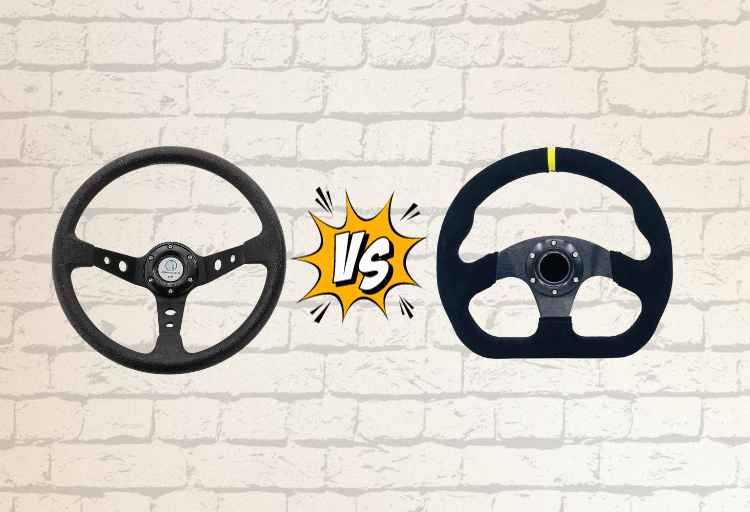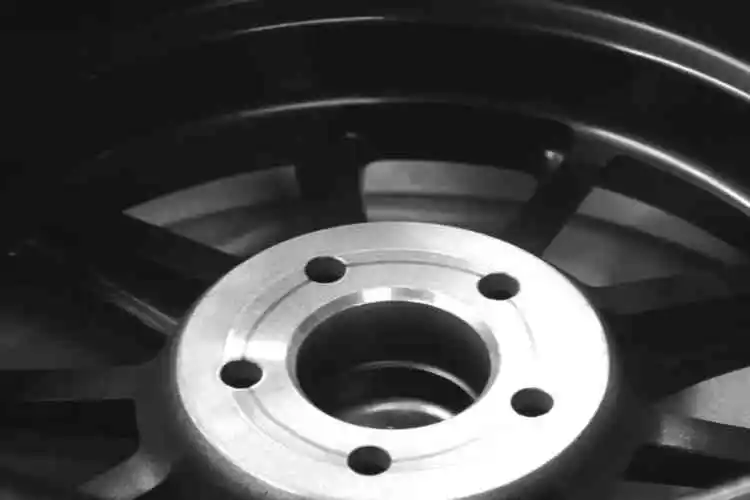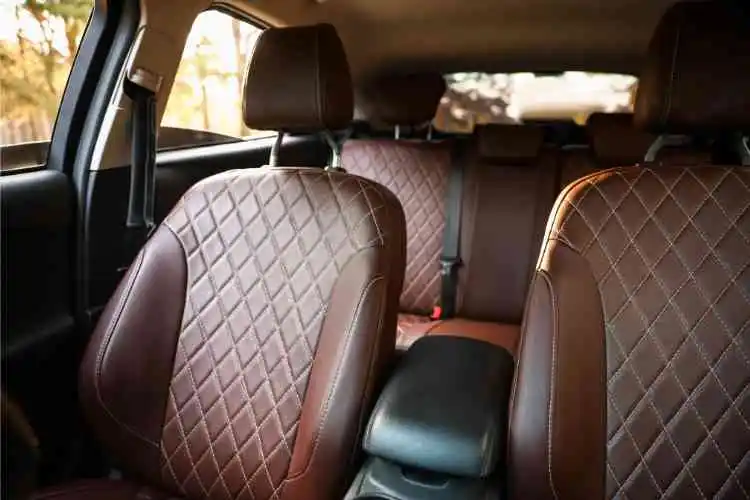Deep-Dish Vs Flat Steering Wheel
When it comes to personalizing your car’s interior, upgrading the steering wheel is a popular choice.
The steering wheel not only serves as a functional component for navigation but also adds to the overall aesthetics of the vehicle. Two common options that enthusiasts often debate over are the deep-dish steering wheel and the flat steering wheel.
In this article, I’ll dive into the characteristics, benefits, and ideal users of each type, helping you make an informed decision based on your preferences and driving habits.

What Is a Deep-Dish Steering Wheel?
A deep-dish steering wheel is an automotive accessory characterized by its distinctive design featuring a greater distance between the hand grip and the mounting surface.
This design creates a sunken or “deep-dish” effect, positioning the steering wheel closer to the driver. Deep-dish steering wheels are often chosen for their sporty appearance and enhanced driving experience.
They are popular among car enthusiasts and drifters due to their ergonomic benefits and increased finger protection during aggressive driving maneuvers.
This type of steering wheel is commonly found in aftermarket offerings and is known for its unique visual appeal and suitability for specific driving styles.
Deep-Dish Steering Wheel: Sporty and Practical
Design and Features
The deep-dish steering wheel is instantly recognizable by its unique design, characterized by a longer dish distance between the hand grip and the mounting surface.
This design creates a submerged grip that brings the steering wheel closer to the driver.
One of the most prominent benefits of the deep-dish style is its sporty vibe, often sought after by car enthusiasts who want to enhance the visual appeal of their vehicles.
Benefits for Drivers
One of the primary advantages of the deep-dish steering wheel is its suitability for drivers who struggle to reach the wheel comfortably.
By positioning the steering wheel closer to the driver, it ensures a more ergonomic and comfortable driving experience.
This is particularly beneficial for those who may have shorter arms or need a more natural hand placement.
Performance in Drift Cars
The deep-dish steering wheel has found a niche in the world of drift cars.
During drifting maneuvers, the spokes of a traditional flat steering wheel could potentially interfere with the driver’s fingers.
The deep-dish design mitigates this risk, providing a safer environment for aggressive driving.
Enhanced Interior Aesthetics
Beyond its functional benefits, the deep-dish steering wheel contributes to the overall aesthetics of the car’s interior.
Its visually appealing design stands out and adds a touch of uniqueness that sets your vehicle apart from the rest.
Advantages of a Deep-Dish Steering Wheel
- Provides better grip: The concave shape of a deep-dish steering wheel allows the driver to have a better grip on the wheel, which can be especially helpful when driving at high speeds or in wet conditions.
- More control: The deeper center of a deep-dish steering wheel allows the driver to have more control over the car, making it easier to make quick turns and maneuvers.
- Racing-style look: Deep-dish steering wheels are often associated with racing cars, so they can give your car a sporty, high-performance look.
Disadvantages of a Deep-Dish Steering Wheel
- Less legroom: Because of their concave shape, deep-dish steering wheels can take up more space in the driver’s seat area, which can be uncomfortable for taller drivers or those who need more legroom.
- Less comfortable for long drives: The deeper center of a deep-dish steering wheel can be less comfortable for long drives because it can put more pressure on the driver’s hands and wrists.
What Is a Flat Steering Wheel?
A flat steering wheel is a type of steering wheel that has a flat or slightly curved shape. Unlike a deep-dish steering wheel, a flat steering wheel does not have a concave shape in the center. Flat steering wheels are often used in luxury cars because they provide a sleek, modern look.
Flat Steering Wheel: Versatile and Functional
Universal Design
The flat steering wheel is the standard choice in the majority of cars on the market.
Its grip and mounting surface are almost at the same height, offering a straightforward and functional design that caters to a wide range of drivers.
Comfort and Legroom
One of the key advantages of the flat steering wheel is its ability to provide ample legroom.
This is particularly advantageous for taller or bigger drivers who may find a deep-dish steering wheel to be more restrictive in terms of space.
The flat design ensures that leg movement is not obstructed during long drives or when entering and exiting the car.
Steering Control and Safety
The flat steering wheel’s design contributes to a clear sense of wheel direction, aiding in precise steering control.
This is beneficial for all types of driving scenarios, including regular commuting and highway cruising.
Moreover, the flat design reduces the risk of accidental activation of wipers or indicators, which could occur with a deep-dish steering wheel.
Advantages of a Flat Steering Wheel
- More legroom: Because of their flat shape, flat steering wheels take up less space in the driver’s seat area, providing more legroom for drivers who need it.
- Comfortable for long drives: The flat shape of a flat steering wheel can be more comfortable for long drives because it distributes pressure more evenly across the driver’s hands and wrists.
- Sleek, modern look: Flat steering wheels are often associated with luxury cars and can give your car a modern, high-end look.
Disadvantages of a Flat Steering Wheel
- Less grip: The flat shape of a flat steering wheel can make it harder for drivers to get a good grip on the wheel, especially in wet conditions.
- Less control: The lack of a concave shape in the center of a flat steering wheel can make it harder for drivers to have as much control over the car, especially when making quick turns or maneuvers.
Deep-Dish Vs Flat Steering Wheel: Differences and Similarities
Design and Proximity
The most noticeable distinction between the two types of steering wheels lies in their design and proximity to the driver.
Deep-dish steering wheels are closer to the driver, while flat steering wheels maintain a standard height. This has implications for both comfort and driving style.
Usage Scenarios
Deep-dish steering wheels are well-suited for passionate drifters and drivers who prefer a more immersive driving experience.
On the other hand, flat steering wheels are versatile and cater to a broader range of driving habits, making them a practical choice for daily driving.
Commonality and Availability
Flat steering wheels are the norm in the automotive industry, found in over 90% of cars. They are easily accessible, both in new vehicles and as aftermarket accessories.
Similarly, deep-dish steering wheels can also be found in the market, often appealing to a niche audience seeking a distinctive look and enhanced driving dynamics.
Choosing the Ideal Steering Wheel for You
Deep-Dish: A Blend of Style and Functionality
For those who appreciate unique designs, have a passion for drifting, or simply want to add a sporty touch to their car’s interior, the deep-dish steering wheel is an excellent choice.
It offers both aesthetic appeal and practical benefits for drivers who value a closer reach to the wheel.
Flat: Versatility and Comfort Combined
The flat steering wheel caters to a wider audience, making it suitable for all drivers, regardless of their body size or driving preferences.
If comfort, legroom, and ease of use are your priorities, the flat steering wheel offers a versatile and functional solution that adapts to various driving scenarios.
Conclusion
In conclusion, choosing between a deep-dish and flat steering wheel comes down to personal preference and driving needs.
Both have their advantages and disadvantages, and it’s important to consider what’s most important to you when making your decision.
Whether you choose a deep-dish or flat steering wheel, make sure to choose one that’s comfortable and provides the control and grip you need to drive safely and confidently.





